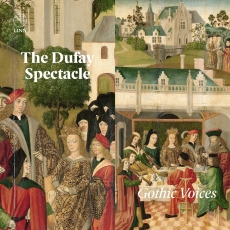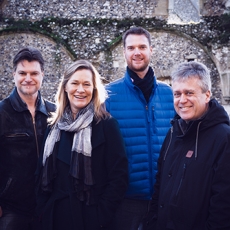Gothic Voices - The Dufay Spectacle - The Consort
The group Gothic Voices will be well-known to many readers of this journal. Formed in 1981, they established a worldwide reputation during the 1980s and 90s for beautifully sung and thoroughly researched recordings of medieval vocal music on the Hyperion label, largely sung unaccompanied, as contemporary sources suggest was the case. The recordings were invariably complemented by a substantial booklet with full textual translations plus elegantly written, thought-provoking and erudite notes by their (non-singing) director, Christopher Page. Indeed, many lovers of their recordings agreed that the booklets alone were worth the price of the disc!
Under Page's direction, Gothic Voices made more than 24 important recordings of medieval music. A Feather on the Breath of God: sequences and hymns by Abbess Hildegard of Bingen (CD A66039), recorded on vinyl in 1981 and then re-issued on CD in 1984, was particularly successful. Gothic Voices went on to produce a series of outstanding recordings, often with historical themes: The Service of Venus and Mars: Music for the Knights of the Garter, 1340-1440 (CD A66238) appeared in 1987.
Music for the Lion-hearted King (CD A66336) followed in 1989 and they began to establish a worldwide reputation. The departure of Christopher Page from the group, in order to pursue research, must have been a serious blow to them, but this is now the fourth disc that Gothic Voices have produced for Linn Records since his departure - and it is a most impressive album in my view. The 'Dufay Spectacle' to which the title refers is an imaginary New Year feast, at which various pieces of Dufay's music are performed.
Guillaume Dufay (c. 1397-1474) was a composer with an international reputation, and his music has often been described as`the final flourishing of the European Middle Ages'. He is celebrated as an outstanding musician in a number of contemporary texts and letters - one motet text described him as luna totius musicaeatque cantorum lumine ('the moon of allmusic, and the light of singers'). After receiving his early training at Cambrai Cathedral, Dufay worked in Rimini and Pesaro for the Malatesta family, and then in Florence and Ferrara, and became a member of the Papal Chapel in Rome.
Indeed, his most famous motet, Nuperrosarumflores ('Lately, rose garlands'), was performed on the magnificent occasion when Florence Cathedral was consecrated in March 1436 by Pope Eugenius IV. Although Nuper rosarum isn't on this disc, the music chosen reminds us of his Florentine and papal connections: track 14 is his three-part motet in praise of the Tuscan people, Salveflos Tuscae gentis ('Hail, flower of the Tuscan people'), and track 16 is Ecclesiaemilitantis ('Of the Church militant'), a five part motet in praise of Pope Eugenius. Dufay is the most important composer of the so-called Burgundian or Franco-Netherlandish School. By the time of his death in 1474, the dukes of Burgundy had expanded their territories (using the traditional medieval methods of conquest, marriage and purchasing power) to include large parts of what are now north-eastern France, Belgium and the Netherlands. Burgundy had become both economically and politically important during the later stages of the Hundred Years War (1337-1453), as European trade in commodities such as wool, textiles, salt and wines from Poitou and Gascony passed through its thriving commercial centres. Bruges was the most important of these, although Ypres, Lille, Ghent and Antwerp were also significant trading and manufacturing centres.
Bruges had resident 'nations' of merchants from all over Europe - from England, Scotland, Venice, Florence, Lucca and from Hanseatic League towns such as Hamburg and Lubeck. International currency exchange was also important in Bruges: from 1439-91 it housed a branch of the Medici Bank, and there was a rudimentary stock exchange. All these commercial activities were not only profitable for the merchants and financiers, but also for the dukes who taxed them heavily. Burgundy prospered culturally, as any visitor to Bruges can see at first hand even today, and the Burgundian court became an important musical centre, many of its musicians having trained in the choir schools of the cathedrals of Cambrai and Liege.
The courtly gatherings of the Dukes of Burgundy (usually held at Bruges, Dijon and Lille) were noted for their music, which was supplied by locally-trained musicians including Guillaume Dufay, Gilles Binchois, Pierre Fontaine, Nicolas Grenon and Jacques Vide. Indeed, Dufay was only one of a group of musicians who trained at Cambrai or Liege and went on to serve in the Papal Chapel in Rome and to enjoy international reputations - others include Arnold and Hugho de Lantins, Guillaume Malbecque and Johannes de Limburgia. The music on this disc is not only an interesting selection of Dufay's work, but provides good examples of the main musical forms of this 'golden age' of Burgundian polyphonic vocal music. Dufay's music would influence European composition for at least a century after his death. As the disc reveals, his music has a much greater sense of harmonic direction than that of his predecessors: triadic harmony is quite frequent, and dissonance is carefully handled so that it occurs only on weak beats or passing notes.
The musical forms here include motets -vocal polyphony with different texts sung simultaneously, the upper voices singing florid parts as the lower ones establish a foundation built of repeated patterns - as well as ballades and rondeaux. The latter are French chansons with their musical form determined by the underlying poetic structure, often known as formes fixes. The texts of these songs are in the rather stylised and artificial language of fifteenth-century poets, often concerning the frustrations of courtly lovers, but the music makes them well worth hearing.
Overall, the disc is excellently performed- the singing is clear and precise throughout, in the finest tradition of Gothic Voices, and although instruments are used for accompaniment (as was likely in this period), the Linn engineers have achieved a fine balance between voices and instruments: the singing emerges above the instrumental texture. The accompanying instruments used (all are 'historically justifiable') include chamber organ, regal, sackbut, shawm, doucaine, vihuela and bray harp. The characteristic sound of bray pins vibrating against the harp strings is heard to great effect on tracks 5 and 21. Some occasional low organ notes have been added for dramatic effect to some of the motets, and while this is not strictly authentic, it adds dramatic colour at key points - I loved it! Crucially, the recording has been made in the spacious acoustic of Boxgrove Priory Church in Sussex, which has only a slight reverberation, allowing all the details to emerge. One has the impression of intimacy- that the singers are very near. The CD box is beautifully produced: it features a delightful and most appropriate panel painting depicting instrumentalists playing at a feast, by an anonymous artist known as the Master of the St Elizabeth Panels who was active in northern Europe in the early 1490s, about twenty years after Dufay's death.
Texts of all the pieces are given together with reliable translations, although in my view, the sleeve notes (by Julian Podger, one of the Gothic Voices singers) are helpful but a little on the short side for a disc of this type: the music is historically important, although quite esoteric, and surely requires more historical contextualisation than Podger provides here. However, he is clearly a fine singer, and Linn Records may well have taken a conscious decision to not try and emulate Christopher Page's work for Hyperion in this respect.

